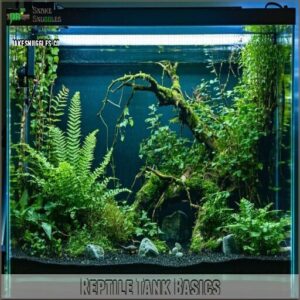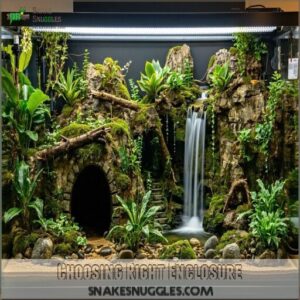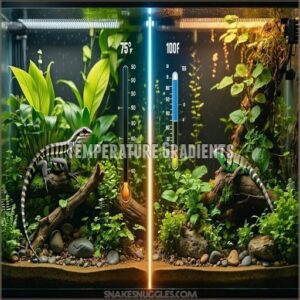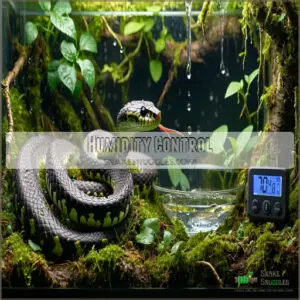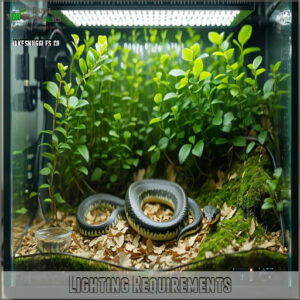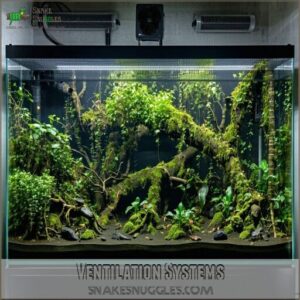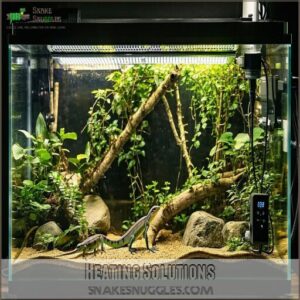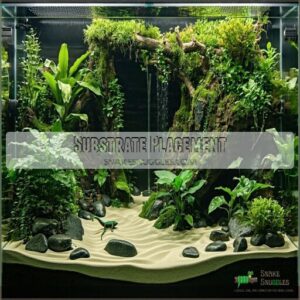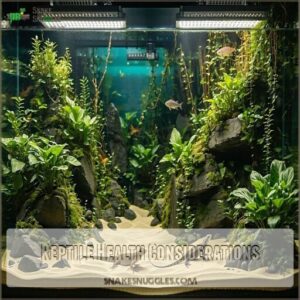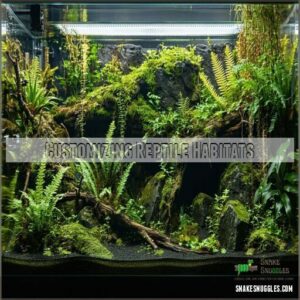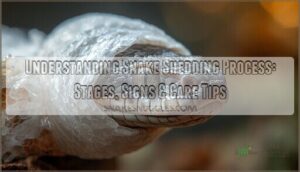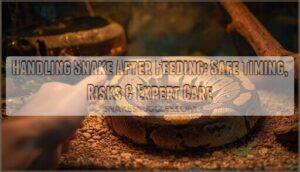This site is supported by our readers. We may earn a commission, at no cost to you, if you purchase through links.
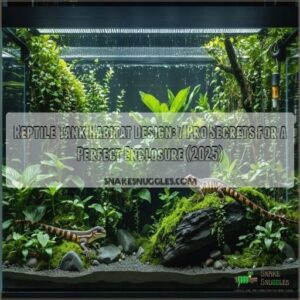 You’re designing a reptile tank habitat, and it’s essential to get it right.
You’re designing a reptile tank habitat, and it’s essential to get it right.
Reptile tank habitat design involves choosing the right enclosure, substrate, and lighting to replicate your pet’s natural environment.
Consider your reptile’s species, size, and behavioral traits to create a customized space.
With the right temperature gradients, humidity control, and lighting, you’ll be well on your way to creating a thriving ecosystem.
Now, let’s get started on building a habitat that’ll make your reptile feel right at home, with expert tips and tricks to make sure a happy and healthy pet.
Table Of Contents
- Key Takeaways
- Reptile Tank Basics
- Choosing Right Enclosure
- Habitat Design Essentials
- Enclosure Features Importance
- Reptile Health Considerations
- Customizing Reptile Habitats
- Frequently Asked Questions (FAQs)
- What do you put on the bottom of a reptile tank?
- What are the habitat requirements for reptiles?
- What is the best habitat for reptiles?
- What 5 basic things are needed to house a reptile?
- What plants are safe for reptiles?
- Can reptiles thrive in outdoor tanks?
- How often clean reptile tank filters?
- Are reptile tanks noisy at night?
- Do reptiles recognize tank decorations?
- Conclusion
Key Takeaways
- You’ll need to research your reptile’s species-specific requirements to create a customized space that meets their needs, including temperature gradients, humidity control, and lighting.
- Choosing the right enclosure size and substrate is crucial, as it directly impacts your reptile’s health and comfort, and natural behaviors, so make sure to select an enclosure that matches your pet’s growth potential and behavioral traits.
- To replicate your reptile’s natural habitat, you’ll need to set up a temperature gradient, maintain proper humidity levels, and provide a mix of UVB lighting and heat lamps, ensuring a thriving ecosystem that supports your pet’s health and well-being.
- Regular maintenance is key to your reptile’s health and happiness, so you’ll need to clean the tank regularly, monitor water quality, and replace filters as needed to prevent bacterial growth and maintain a clean and comfortable environment.
Reptile Tank Basics
You’ll need to match your reptile’s specific requirements to the right enclosure size and substrate for ideal health.
Proper tank setup creates a foundation for temperature regulation, humidity control, and natural behaviors that keep your scaly friend thriving, which is essential for ideal health.
Species Requirements
Three fundamental principles govern successful reptile habitats.
First, each reptile species has distinct behavioral traits requiring customized environments.
Desert dwellers need arid conditions, while tropical species thrive in humidity.
Appropriate substrate selection is essential for reptile health.
Second, social needs vary dramatically – some reptiles need solitude, others benefit from interaction.
Third, proper substrate selection directly impacts health.
Always conduct thorough species research before setup, as species-specific care guarantees habitat security and prevents stress-related issues.
Enclosure Size Considerations
Getting the right enclosure size can make or break your reptile’s health.
Tank dimensions must accommodate your pet’s adult size and natural behaviors.
- Measure at least 1.5 times your reptile’s length for adequate space requirements
- Consider enclosure depth for burrowing species like sand boas
- Allow vertical habitat volume for arboreal species like crested geckos
- Factor in reptile growth to avoid frequent tank upgrades
Substrate Selection
Now that you’ve measured your tank, selecting the right substrate creates the foundation for your reptile’s home.
Your choice of bedding materials impacts humidity levels, digging behavior, and overall comfort.
Smart substrate selection helps maintain proper moisture control while preventing health issues.
For snakes, proper substrate selection impacts health, especially concerning humidity and burrowing needs.
| Substrate Types | Moisture Control | Best For |
|---|---|---|
| Reptile Carpet | Low | Bearded Dragons |
| Coconut Fiber | High | Tree Frogs |
| Reptile Sand | Medium | Desert Species |
| Bio-Active Soil | High | Tropical Lizards |
| Wood Chips | Medium | Ground Dwellers |
Choosing Right Enclosure
You’ll need to select an enclosure that matches your reptile’s natural behaviors and growth potential for best health.
The right tank considers your pet’s climbing habits, humidity needs, and offers adequate space for movement while maintaining proper temperature gradients, which supports the pet’s overall well-being and growth potential.
Reptile Species Types
Understanding reptile diversity starts with recognizing the main species classifications.
Reptile species fit into distinct habitat categories based on behavior and adaptation needs:
- Arboreal reptiles live primarily in trees and need vertical space
- Terrestrial reptiles require ground-level habitats with ample floor space
- Aquatic reptiles need water features and specialized filtration
- Desert reptiles thrive in arid environments with proper heat gradients
- Semi-arboreal species benefit from combined climbing and ground areas
Species research confirms your enclosure matches your reptile’s natural lifestyle.
Proper reptile habitat design is essential for creating a suitable environment that meets the specific needs of your pet, ensuring a natural lifestyle with the right habitat categories and proper heat gradients.
Factors Affecting Choice
Now that you know your reptile’s natural behaviors, let’s consider the key factors for enclosure selection.
Tank materials matter – glass offers visibility while wood retains heat.
Your reptile’s needs dictate humidity, temperature, and ventilation requirements.
A suitable reptile enclosure depends on the species and its specific needs.
Species research pays off – arboreal reptiles thrive in vertical setups, while fossorial species need digging space.
Habitat security prevents escapes, and proper enclosure safety reduces stress for your pet.
Size and Layout
The right size and layout form the foundation of your reptile’s happiness.
Your enclosure should measure at least 1.5 times your snake’s length, with proper tank dimensions allowing natural movement.
When planning your reptile habitat design, consider both current size and future growth.
Space planning isn’t just about length—width and height matter for different species.
Smart enclosure shapes and scaling options prevent frequent tank upgrades while ensuring your pet thrives.
Understanding ideal reptile tank sizes is essential for creating a suitable environment.
Habitat Design Essentials
You’ll need to create proper temperature gradients, humidity levels, and lighting systems that match your reptile’s natural habitat requirements.
These three essential elements work together to support your pet’s health, activity levels, and biological functions, much like how we humans need the right living conditions to thrive.
Temperature Gradients
Temperature control makes or breaks your reptile’s habitat.
Your cold-blooded friend needs thermal zones to regulate their body heat naturally.
Set up your tank with a cool side (75-80°F) and a warmer basking area (95-100°F) using heat lamps or ceramic emitters.
Think of it like creating a mini climate system – they’ll move between zones to find their perfect temperature sweet spot.
Maintaining an ideal temperature gradient is vital, and understanding the ideal temperature ranges helps maintain a healthy environment for your pet.
Humidity Control
Everyone knows maintaining proper humidity is important for your reptile’s health and happiness.
Your scaly friend needs precise moisture levels to thrive, just like they’d have in their natural habitat.
- Install humidity sensors and calibrate your hygrometer monthly for accuracy
- Position water bowls strategically for natural evaporation
- Use fogging systems during dry seasons
- Set up spray misters on timers for consistent moisture
- Monitor humidity gauges daily and adjust mist systems as needed
By following these steps, you can ensure your reptile’s environment is as close to their natural habitat as possible, which is crucial for their well-being and happiness.
Lighting Requirements
To replicate your reptile’s natural habitat, you’ll need a mix of UVB lighting and heat lamps.
Most reptiles thrive with 10-12 hours of light daily, mimicking natural photoperiod control.
Install LED options alongside UVB bulbs for a complete lighting system.
Position your lighting fixtures strategically – UVB needs direct exposure while heat lamps create basking zones.
Consider timers to maintain consistent lighting cycles.
Enclosure Features Importance
You’re designing a reptile tank habitat, and it’s essential to evaluate the enclosure’s features.
By prioritizing ventilation systems, heating solutions, and substrate placement, you’ll create a comfortable and healthy environment for your reptile.
This approach allows for a well-planned space that incorporates all necessary elements, including heating solutions, to ensure the reptile’s well-being.
Ventilation Systems
You design a reptile tank with proper ventilation, considering air flow, vent types, and fan systems.
Mesh screens and exhaust ports help control humidity, ensuring a healthy environment.
Reptile ventilation depends on enclosure size, tank material, and humidity control, so choose wisely to create a thriving space.
Heating Solutions
You’ll need heating solutions like Heat Lamps, Heat Mats, or Thermostat Systems to maintain temperature gradients.
These heating elements, paired with reptile lighting and UVB lighting, create a perfect environment, giving you control over temperature gradients and heat sources for your reptile’s comfort and well-being.
Proper heat lamp systems require understanding of heat lamp products to guarantee the right equipment is chosen for the enclosure, ensuring a suitable environment with the right temperature gradients and heat sources.
Substrate Placement
When setting up your reptile tank, consider substrate placement carefully, taking into account substrate depth, moisture levels, and humidity control, as different substrate types suit various reptile species.
Incorporating digging areas can enhance habitat design, making your terrarium setup a thriving environment.
Proper reptile care involves understanding reptile substrate options to create a suitable habitat.
Reptile Health Considerations
You’re responsible for creating a healthy environment for your reptile, and that starts with understanding their specific needs.
By considering factors like disease prevention, injury prevention, and stress reduction, you can design a reptile tank that keeps your pet happy and thriving.
Disease Prevention
Preventing disease is critical for reptile health.
To maintain sanitation methods and hygiene practices, consider:
- Regular health checks
- Quarantine procedures
- Proper humidity control
- Infection control measures to guarantee reptile wellbeing and safety in habitat maintenance.
This can be achieved by focusing on complete concepts and ensuring that each group of ideas is clearly separated for better readability, with an emphasis on reptile wellbeing.
Injury Prevention
You make sure reptile safety by prioritizing safe handling, escape prevention, and fall protection.
While also considering electrical safety and thermal burns to create a secure enclosure with escape-proof locks, minimizing reptile stress and promoting habitat safety.
Stress Reduction
You create calming environments by providing hide options, sensory stimulation, and environmental enrichment, reducing reptile stress through behavioral therapy and naturalistic appearance.
Offering hiding spots and reptile enrichment to promote well-being is also crucial, as it directly contributes to the reduction of stress and improvement of the reptiles’ quality of life, aligning with the goal of creating calming environments through reptile enrichment.
Customizing Reptile Habitats
You’re about to create a customized reptile habitat that meets your pet’s specific needs.
By choosing the right accessories, landscaping features, and maintenance tips, you can build a thriving environment that keeps your reptile happy and healthy, which is crucial for creating a customized reptile habitat.
Accessorizing Options
You can accessorize with:
- Decor Items
- Water Features
- Hide Options
- Climbing Structures, adding sensory toys and reptile plants for a stimulating tank decoration, enhancing reptile hiding and overall experience with water features and decor.
This allows for a stimulating tank decoration, where you can combine these elements to create an engaging environment.
Landscaping Features
You design your reptile tank with rock placement and water features.
Proper reptile habitat design tips are essential for your pet’s well-being.
| Plant Selection | Branch Arrangements | Hide Structures |
|---|---|---|
| Live plants | Driftwood | Rocks |
| Artificial plants | Tree branches | Plants |
| Aquatic plants | Rock piles | Terracotta pots |
The table outlines various options for reptile habitat design, including plant selection, branch arrangements, and hide structures.
Tank Maintenance Tips
Reptile tank maintenance is key to your pet’s health and happiness. Keep their habitat clean and comfortable with these tips:
- Water Quality: Provide easy access to clean water. Regularly refresh and clean water dishes to prevent bacterial growth.
- Tank Cleaning: Spot-clean daily. Remove waste and leftover food. Deep-clean the entire tank monthly to prevent bacteria and odor.
- Waste Management: Use a scoop for solid waste. Disinfect the enclosure regularly to maintain hygiene and prevent health issues.
- Filter Maintenance: Check filters weekly. Replace or clean as needed to maintain peak water quality and airflow.
The maintenance tasks outlined are crucial for the well-being of your pet, emphasizing the importance of a clean and comfortable environment.
Frequently Asked Questions (FAQs)
What do you put on the bottom of a reptile tank?
Sophisticated substrate selections simplify setup, you’ll typically put substrate like aspen shavings, coconut husk, or reptile carpet on the bottom of your tank.
What are the habitat requirements for reptiles?
You’ll need to research species-specific habitat requirements, considering temperature, humidity, lighting, and space to create a suitable environment for your reptile, ensuring its health and well-being.
What is the best habitat for reptiles?
You’ll create a thriving habitat by mimicking your reptile’s natural environment, considering factors like temperature, lighting, and space to provide their comfort and well-being, and promoting a healthy lifestyle.
What 5 basic things are needed to house a reptile?
Thou seekest a modern menagerie, my friend, you’ll require a terrarium, heat source, UVB lighting, substrate, and hydration system to house your reptile.
What plants are safe for reptiles?
You’ll want plants like spider plants, snake plants, or dracaena, which are safe for reptiles and help maintain humidity and air quality in their enclosure.
Can reptiles thrive in outdoor tanks?
You’ll find that 70% of reptiles can thrive outdoors, but it’s essential you research species-specific requirements to guarantee their safety and well-being in outdoor tanks.
How often clean reptile tank filters?
You should clean reptile tank filters every 1-2 weeks, depending on the species and tank conditions, to maintain ideal water quality and prevent bacterial growth.
Are reptile tanks noisy at night?
You’ll likely hear some noise from reptile tanks at night, such as gentle humming from filters or soft hissing from heating elements, but it’s usually minimal and not disturbing.
Do reptiles recognize tank decorations?
You’ll be surprised that 80% of reptiles recognize tank decorations, using them for basking, hiding, and climbing, which helps reduce stress and promotes a sense of security and comfort.
Conclusion
Building a reptile tank habitat is like crafting a puzzle, and you’re the master builder.
You’ve learned the secrets to creating a thriving ecosystem through reptile tank habitat design, considering temperature, humidity, and lighting.
Now, go ahead and design a perfect enclosure, making your pet’s home a happy and healthy one with expert reptile tank habitat design.

